Protein Calculator
Food Protein Converter
Dial in your daily protein target with evidence-based ranges tailored to your body, activity level, and goals.
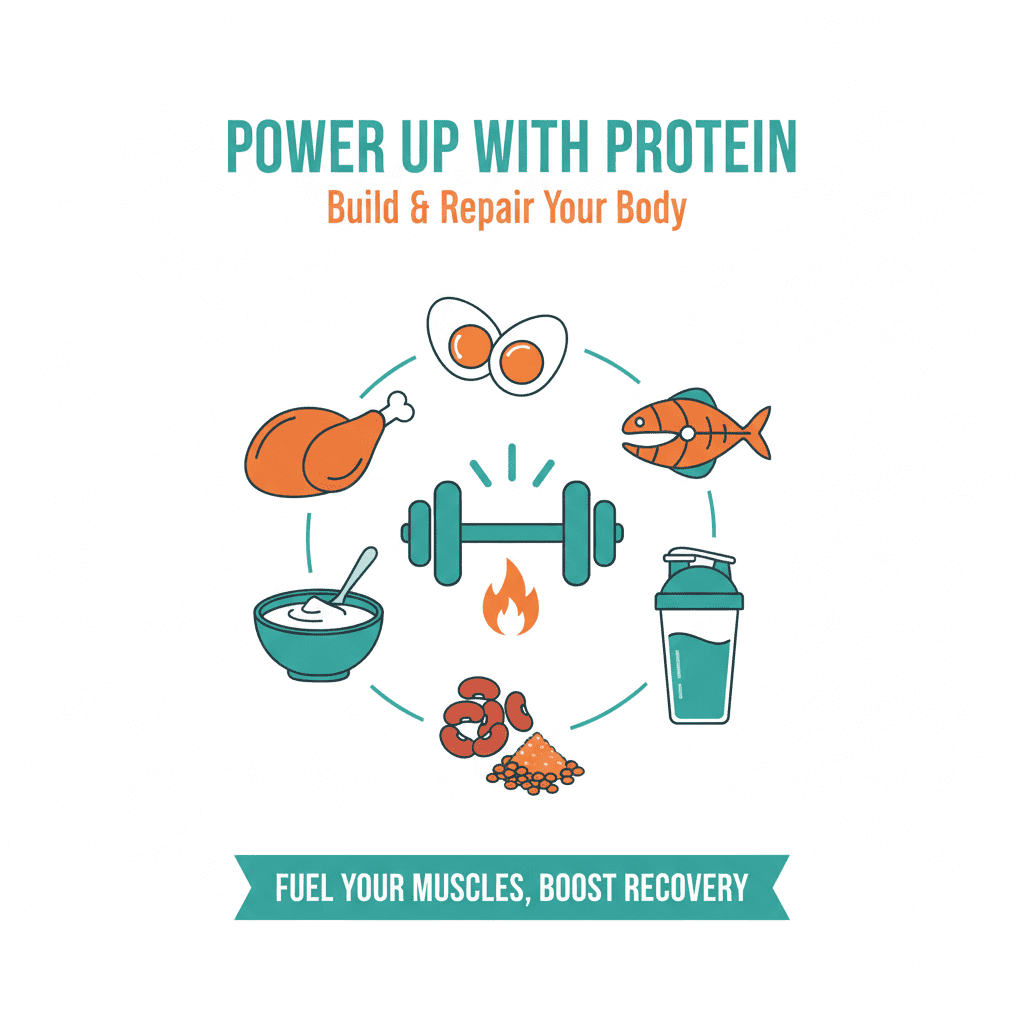
Introduction: Why Protein Precision Matters
Protein is essential yet often misunderstood. Results stall not from lack of effort, but from guessing. Your daily protein intake strongly influences fat loss, muscle gain, and weight maintenance.
Protein repairs, maintains, and builds tissue. The NutriFitCalc Protein Calculator removes guesswork by estimating needs from sex, age, weight, and activity using evidence-based ratios.
Use precise numbers to align meals with goals so every plate works for you.
What Is a Protein Calculator
A protein calculator estimates daily protein needs using factors such as age, sex, weight, height, and activity. A young athlete training five days weekly needs more than a mostly sedentary office worker.
NutriFitCalc personalizes targets so you do not rely on vague advice. It draws on guidance from leading organizations that set protein needs per kilogram of body weight.
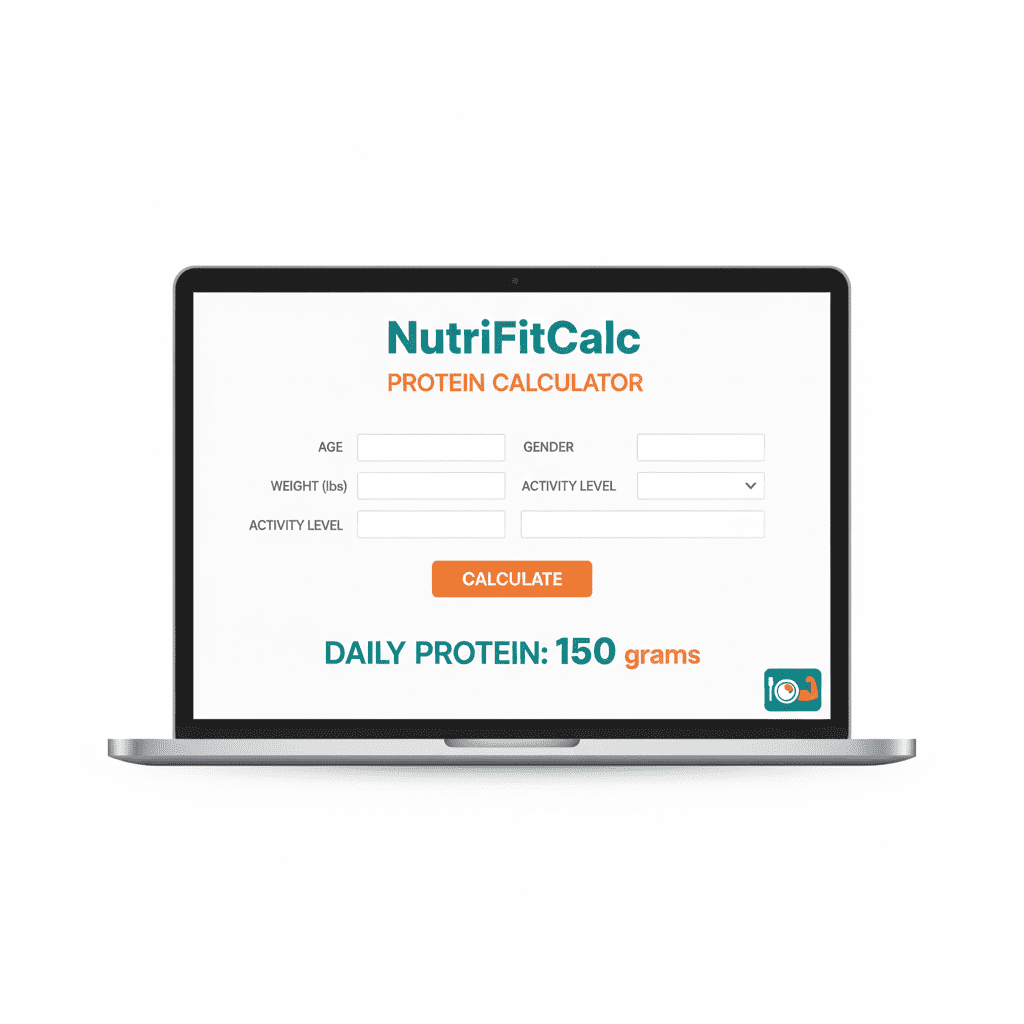
Why Protein Is So Important
Protein supplies amino acids for enzymes, hormones, immune factors, and muscle repair. It has a higher thermic effect than carbs or fats, which supports a healthy metabolic rate and appetite control.
Protein helps regulate hunger hormones and supports lean mass across the lifespan. Harvard Health notes regular intake supports muscle preservation and cardiovascular health.
How the NutriFitCalc Protein Calculator Works
- Enter sex, age, and weight.
- Select activity level: sedentary, moderate, or active.
- Choose goal: maintenance, muscle gain, or fat loss.
- Click Calculate Protein.
For example, many lifters target about 1.8 to 2.2 g/kg for muscle gain. A 70 kg person may land near 126 to 154 g per day. The calculator returns a clear daily range in grams.
Protein Needs by Activity
| Activity level | g protein / kg body weight | Example for 70 kg |
|---|---|---|
| Sedentary (little or no exercise) | 0.8–1.0 | 56–70 g |
| Lightly active | 1.0–1.2 | 70–84 g |
| Active (3–5 days/week) | 1.3–1.6 | 91–112 g |
| Active (6–7 days/week) | 1.6–2.1 | 112–140 g |
| Bodybuilders / intense athletes | 2.0–2.2 | 140–154 g |
Insufficient protein is linked with fatigue, impaired immunity, and muscle loss. Use the Protein Calculator to hit targets consistently.
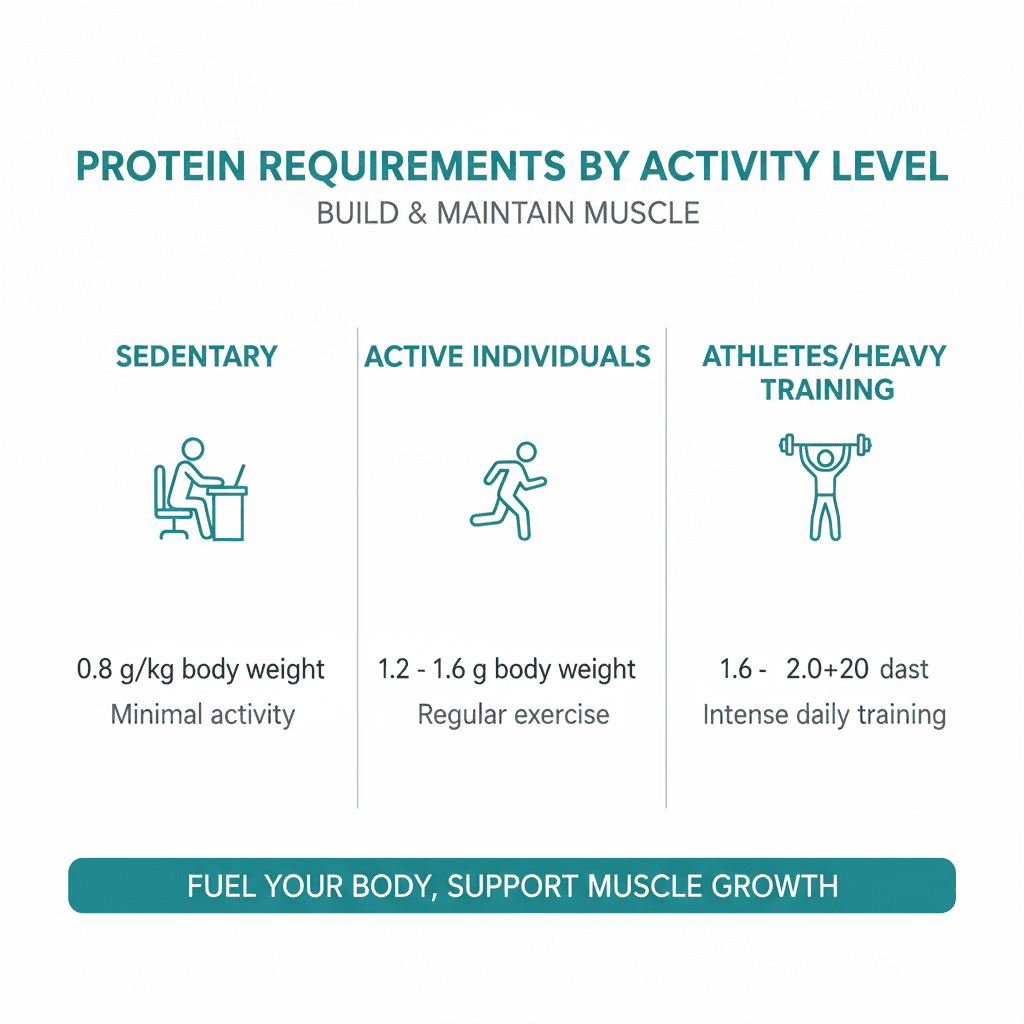
Protein and Weight Loss
Higher protein supports fat loss by improving satiety and preserving lean mass. A common cut phase range is about 1.6–2.2 g/kg while maintaining a modest calorie deficit.
Pair with resistance training and plan energy using the Calories Calculator so the deficit targets fat, not muscle.
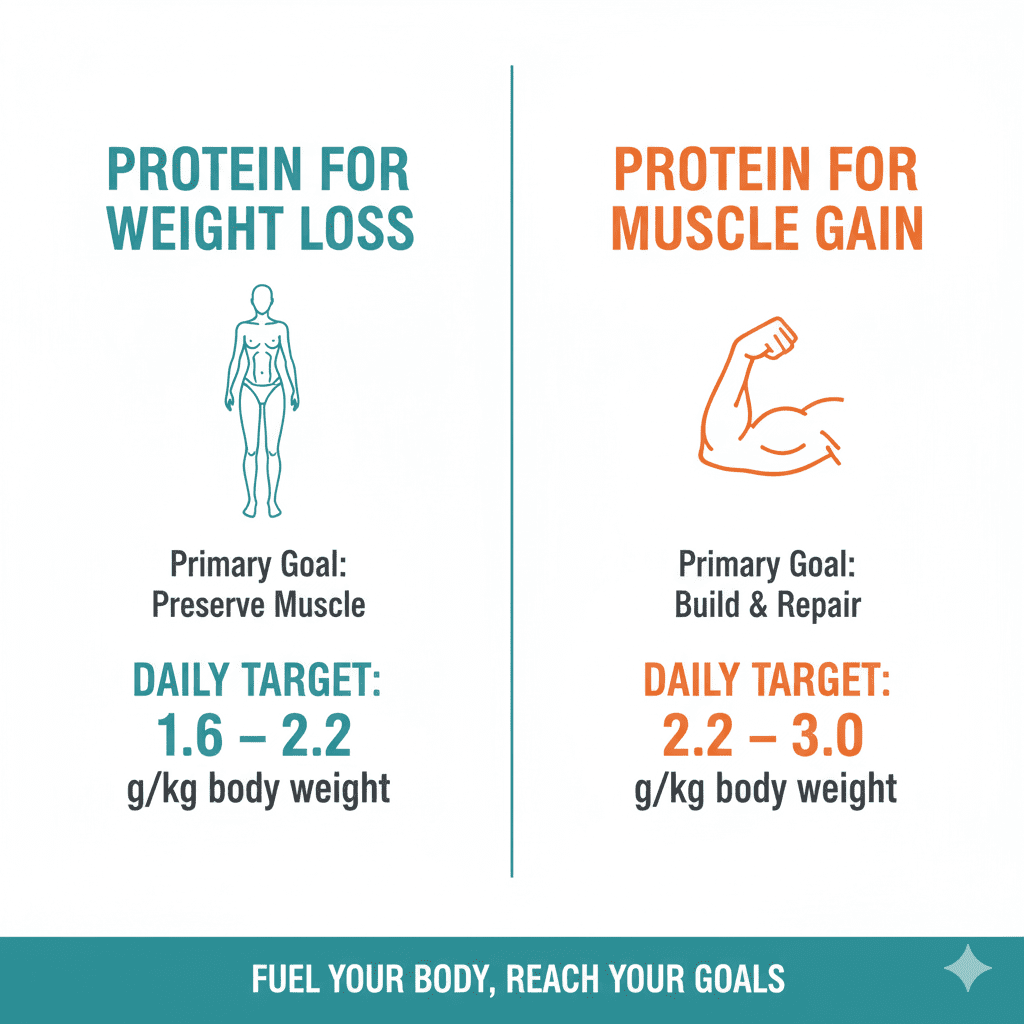
Protein for Muscle Gain
Muscle gain requires a calorie surplus and adequate protein to stimulate muscle protein synthesis. Many aim for about 1.8–2.2 g/kg, spread across 4–5 meals to maintain a steady amino acid supply.
Consistency matters. Combine with progressive overload, sleep, and hydration. Use the Protein Calculator for a precise daily target.
Protein for General Maintenance
For overall health, many adults target about 0.8–1.2 g/kg. This supports cell repair, hormone production, and stable energy. Balanced intake is associated with improved focus and immune strength.
Top Protein-Rich Foods
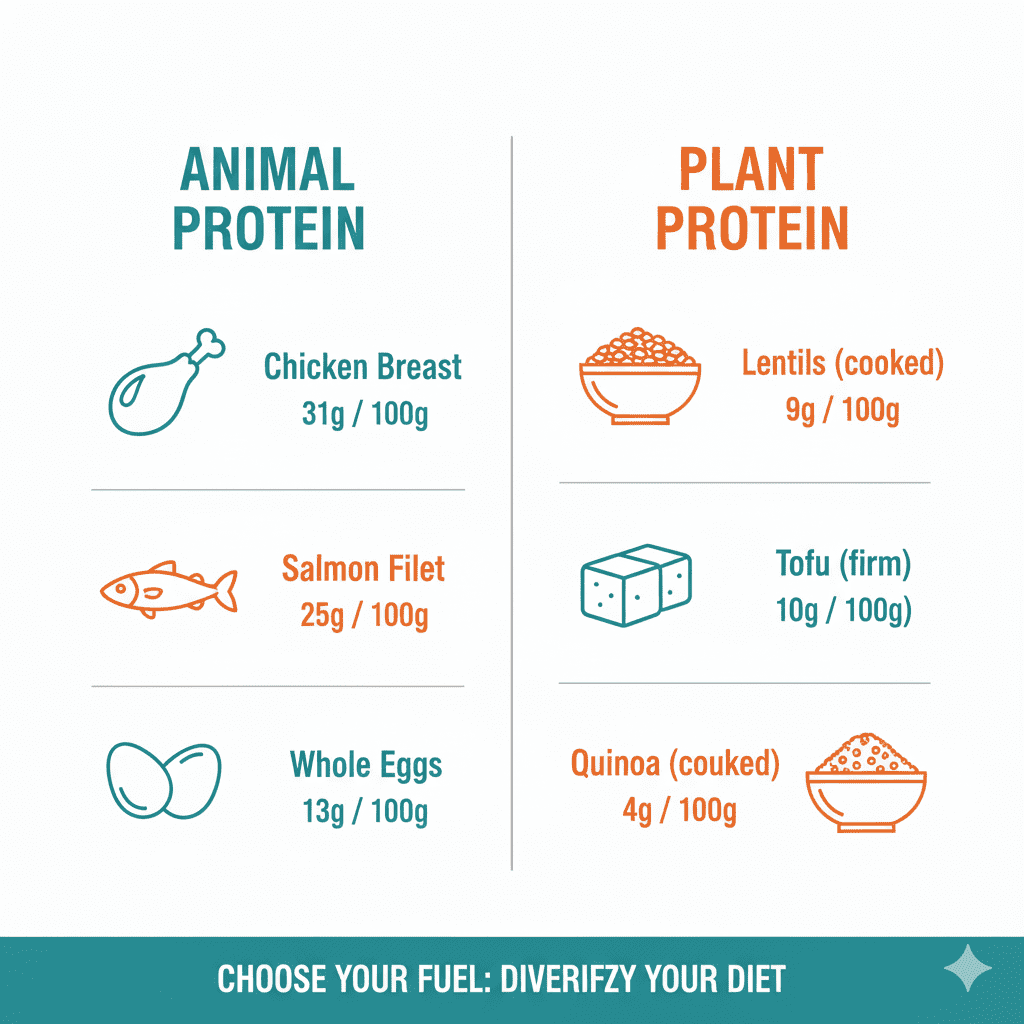
Animal-based
- Chicken breast ≈ 31 g per 100 g
- Turkey ≈ 29 g
- Fish (salmon, tuna, cod) ≈ 20–25 g
- Eggs ≈ 13 g
- Greek yogurt or cottage cheese ≈ 10–11 g
- Lean beef ≈ 26 g
Plant-based
- Lentils and beans ≈ 9–21 g
- Chickpeas ≈ 19 g
- Tofu or tempeh ≈ 8–18 g
- Quinoa, oats ≈ 4–6 g
- Nuts and seeds ≈ 15–25 g
Combine plant proteins, such as rice and beans, to round out amino acids. Use your Protein Calculator result to plan servings across the day.
Examples: Turning Numbers Into Meals
Example 1 — Fat loss
Profile: female, 60 kg, sedentary. Target: 1.6 × 60 = 96 g/day. Split over four meals at ~24 g each: Greek yogurt breakfast, lentil soup lunch, grilled salmon dinner, almonds snack.
Example 2 — Muscle gain
Profile: male, 75 kg, active. Target: 2.0 × 75 = 150 g/day. Five ~30 g servings using chicken, eggs, milk, beans, and a post workout whey shake.
For energy planning, pair with the Calories Calculator and BMR Calculator.
Quick Guide: How Much Protein Do You Need
| Goal | g/kg body weight | Example (70 kg) |
|---|---|---|
| Weight loss | 1.6–2.2 | 112–154 g |
| Muscle gain | 1.8–2.2 | 126–154 g |
| Maintenance | 1.0–1.4 | 70–98 g |
| Endurance athletes | 1.4–1.8 | 98–126 g |
| Strength training focus | 2.25–2.5 | 158–175 g |

Protein Myths — Clarified
- Myth: High protein harms kidneys. Fact: Healthy adults typically tolerate intakes up to about 2.2 g/kg; those with kidney disease should follow medical guidance. Harvard Health • JISSN
- Myth: You can only absorb 30 g per meal. Fact: Total daily intake matters most. Digestion and utilization continue over hours.
- Myth: Protein makes you bulky. Fact: Visible hypertrophy requires resistance training and sufficient calories.
- Myth: Supplements are mandatory. Fact: Whole foods can meet needs; powders are convenience options.

How to Hit Your Daily Protein Target
- Plan ahead and prep portions.
- Include protein at every meal: eggs or yogurt at breakfast, legumes or lean meats at lunch and dinner.
- Use smart snacks such as nuts, cheese, protein bars, or smoothies.
- Distribute intake evenly: many aim for 20–40 g per meal.
- Stay hydrated with about 2–3 liters of water per day.
- Combine resistance training with adequate protein for best results.
Useful Internal Links
Trusted External References
FAQs
How much protein should I eat for weight loss
Many aim for about 1.6–2.2 g/kg per day to preserve muscle and support metabolism while in a calorie deficit.
How much protein for muscle gain
Common targets are 1.8–2.2 g/kg per day, spread over 4–5 meals, paired with resistance training.
Can too much protein cause side effects
Healthy adults generally tolerate higher intakes when overall diet is balanced. Follow medical guidance if you have kidney or metabolic conditions.
What are the best protein sources
Chicken, fish, eggs, dairy, lentils, beans, tofu, tempeh, and nuts. Choose a mix that fits your preferences.
How can I measure protein in my meals
Use the Protein Calculator to plan grams per day and divide across meals based on food labels or standard composition tables.